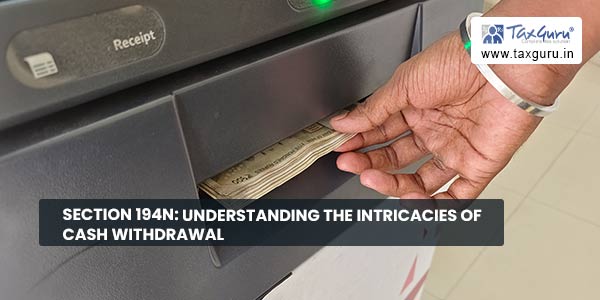Earlier withdrawing cash from the bank was a tedious task and involves a lot of efforts and time. But with the technological advancements, we no longer require to withdraw cash regularly. And with the ongoing state of Covid-19, UPI & Digital payments took over cash transactions.
The Government of India also to boost digital economy and to curb generation of black money, had taken multiple initiatives such as introduction of Section 194N, mandatory furnishing of PAN or Aadhaar Card for withdrawals among others.
Here, we understand the various steps initiated by the government:
Section 194N applies to every person (including Non-Resident), being
- a Banking Company to which banking regulation Act, 1949 applies;
- or a co-operative society engage in carrying business of banking;
- or a post office
who is responsible for paying any sum, being the amount or aggregate of amounts, as the case may be, in cash exceeding 1 crore during the previous year, to any person from one or more accounts maintained by such recipient-person with it, shall deduct tax at source @2% of such sum at the time of payment.
*Every Person includes an Individual, a HUF, a Company, a Partnership Firm or an LLP, a Local Authority, an AOP or BOI.
Enumerating the same through table:
| Limit for TDS on Cash Withdrawals | TDS Rate |
| Cash Withdrawal upto Rs. 1 Crore | 0% |
| Cash Withdrawal exceeding Rs. 1 Crore | 2% |
(The above table is applicable to those who have filed their income tax returns for previous 3 years)
In case, the people who have not filed their income tax returns for ALL the previous 3 years and for which the due date has expired, the TDS Rate shall be as follows:
| Limit for TDS on Cash Withdrawals | TDS Rate |
| Cash Withdrawal exceeding Rs. 20 lakhs but not exceeding Rs. 1 Crore | 2% |
| Cash Withdrawal exceeding Rs. 1 Crore | 5% |
NOTE: The recipient cannot apply for lower deduction certificate u/s 197 and cannot furnish form No. 15G/15H.
Further, No TDS shall be deducted if the amount is withdrawn by the following recipients:
- The Government
- any banking company or co-operative society engaged in carrying on the business of banking or a post-office
- any business correspondent of a banking company or co-operative society engaged in carrying on the business of banking, in accordance with the RBI guidelines
- any white label ATM operator of a banking company or co-operative society engaged in carrying on the business of banking, in accordance with the authorization issued by the RBI under the Payment and Settlement Systems Act, 2007
- Such other person or class of persons as notified by Central Government
1. Cash Replenishment Agencies (CRA’s) and franchise agents of White Label Automated Teller Machine Operators (WLATMO’s)
2. Commission agent or trader, operating under Agriculture Produce Market Committee (APMC), and registered under any Law relating to Agriculture Produce Market
3. The authorized dealer and its franchise agent and sub-agent and Full-Fledged Money Changer (FFMC) licensed by the RBI and its franchise agent.
Recently, the Central government again vide Notification No. 53/2022 dt May 10,2022 and with effect from 26th May, 2022 amended the rules where furnishing of PAN or Aadhaar have been made compulsory in the following transactions:
1. High Value Cash Deposits: Cash deposit or deposits aggregating to ₹20 lakh or more in a financial year, in one or more accounts of a person with a banking company or a co-operative bank or a post office.
2. High Value Cash Withdrawals: Cash withdrawal or withdrawals aggregating to ₹20 lakh or more in a financial year, in one or more accounts of a person with a banking company or a co-operative bank or a post office.
3. Opening of Account: Opening of a current account or cash credit account by a person with a banking company or a co-operative bank or a post office

The notification also said that any person who intends to make these transactions should apply for a PAN at least seven days before the date on which the transaction is intended to be made.
Further,
The CBDT has said that under the new rule PAN or Aadhaar, with demographic or biometric information of an individual, shall be submitted to the principal director-general of Income Tax (Systems) or director-general of Income Tax (Systems), or the person authorised by either, for the purposes of authentication as referred to in section 139A.
The principal director-general or director-general shall lay down the format and standards along with procedure for authentication of PAN or Aadhaar.
The Indian Government is frequently introducing monetary reforms to accomplish the goals of a cashless economy and to access data easily and to investigate further into huge transactions. Following the demonetization to introduction of Section 194N to compulsory PAN or Aadhaar reporting is a move to promote digital payments and eliminate cash transactions slowly from the country.





